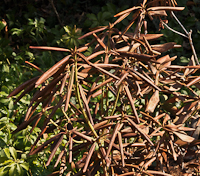|
 |
|
 |
|
 |
|
 |
 |
 The most common form of root rot is caused by the
soil-inhabiting water mold fungus Phytophthora. Many species are
susceptible to this disease and in the home
landscape, the most commonly bothered plants include
azalea,
rhododendron,
Pieris, yews, mountain laurel,
heather, and high-bush
blueberries. The most common form of root rot is caused by the
soil-inhabiting water mold fungus Phytophthora. Many species are
susceptible to this disease and in the home
landscape, the most commonly bothered plants include
azalea,
rhododendron,
Pieris, yews, mountain laurel,
heather, and high-bush
blueberries.
|
 |
|
 |
 |
 This disease is promoted
by high soil moisture content and warm soils so the real
problem is often poor drainage. Root rot is very unusual
in well-drained soils such as
sand and is very common in
those high in
clay content. Over-watering, unusually
heavy rain seasons and hard pan soils may all contribute
to the development of root rot. This disease is promoted
by high soil moisture content and warm soils so the real
problem is often poor drainage. Root rot is very unusual
in well-drained soils such as
sand and is very common in
those high in
clay content. Over-watering, unusually
heavy rain seasons and hard pan soils may all contribute
to the development of root rot.
When the roots rot away,
it inhibits the plant's ability to take in water so, the
result is wilt on the leaves and twigs above ground.
Infected roots turn reddish-brown, become brittle and
die.
|
 |
 |

|
-
Proper Drainage -
Plants that are especially susceptible to this root
rot must be planted in sites that have good
drainage. Sometimes amending the soil with porous
material or planting in raised beds may avoid the
problem.
-
Planting Depth - Be
sure to set plants in the soil at the same depth at
which they were growing in the container or at their
previous site. Planting too deep and burying the
base of stem may stress plants and encourage the
development of the rot in poorly drained sites.
-
Resistant Plants - If
a site has been plagued by root rot in the past,
plant only species not susceptible to Phytophthora.
Even within a genus or species,
there may be cultivars that are more or less
susceptible to the problem. The fungus stays around
in the soil so new, susceptible plants are very
likely to acquire the disease too.
|
 |
 |
 |
Generally the most
effective control of this root rot disease is to follow
the preventative measures listed above. As a last
resort, there are some soil drenching treatments that
may be attempted. This is usually more effective in the
nursery where the plants are all in separate containers
with a small volume of soilless media. In the home
landscape, these treatments are usually not very
effective.
|
|
 |
|
Note: We
have provided some general information and
observations on this topic aimed at the home
gardener. Before you take
any serious action in your landscape, check
with your state's land grant university's
Cooperative
Extension
Service for the most current,
appropriate, localized recommendations. |
|
 |
 |
 |
|
|
 |
|



